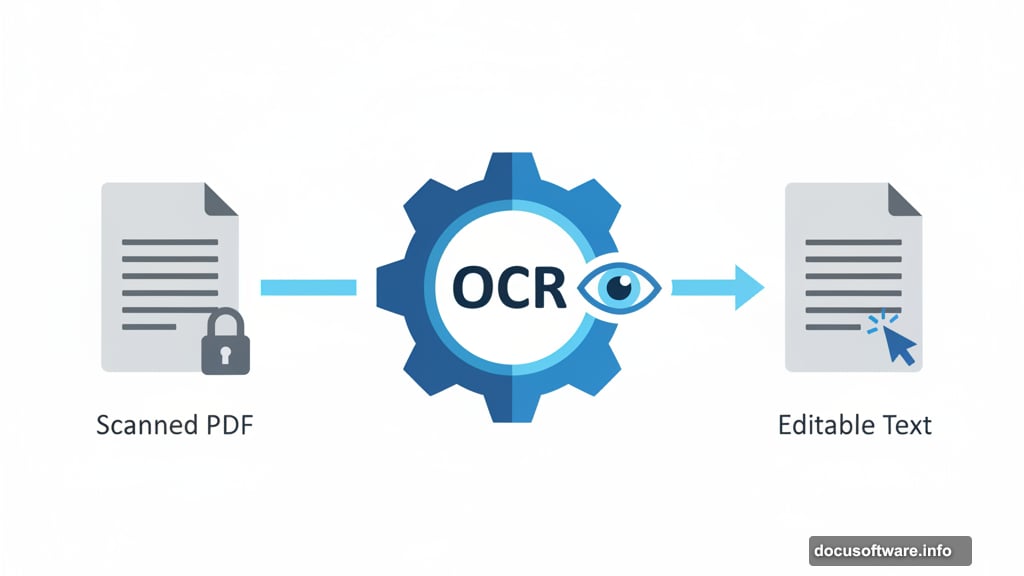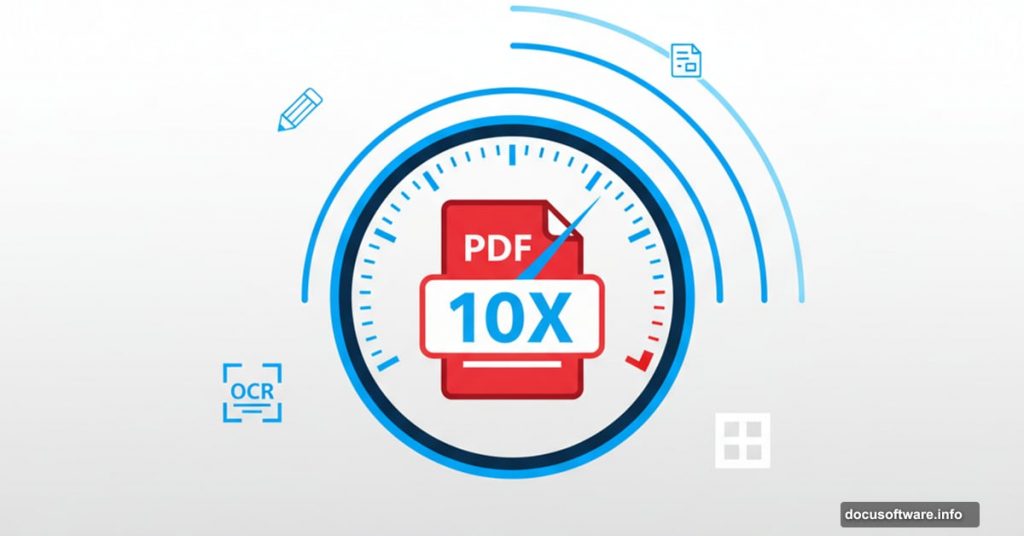PDFs eat up more time than they should. Between editing text, managing pages, and tracking down changes across versions, what should take minutes stretches into hours.
But Adobe Acrobat packs features most users never discover. These hidden time-savers can slash your PDF editing workload dramatically. Let’s break down the 10 tools that actually move the needle.
1. Edit PDF Tool: Your Swiss Army Knife
The Edit PDF tool lives under Tools > Edit PDF. Click it once and you’re ready to modify text, resize images, or adjust layouts directly in your document.
Quick Text Changes
Click any text block to edit immediately. Drag across multiple lines to select ranges. Type directly to replace content while formatting stays intact.
Here’s the catch though. Review your edits carefully before saving. Use ‘Save As’ to create a new version you can compare against the original. This prevents accidental changes from slipping through.
Image Resizing Made Simple
Select any image and drag corner handles to resize. Click and drag images to reposition them anywhere on the page. Plus, you can add, replace, or resize images through the Objects list.
This flexibility keeps your documents looking professional without fighting layout issues.
Layout Adjustments
Drag objects to new positions on your page. Rearrange elements until the visual flow makes sense. Properly arranged layouts help readers navigate content faster and understand information better.
So don’t settle for clunky arrangements. A few minutes of layout tweaking saves readers confusion later.
2. Organize Pages Like a Pro
The Organize Pages tool transforms messy PDFs into structured documents. Add, delete, rearrange, and rotate pages seamlessly to improve readability.
Adding and Deleting Pages
Drag files directly into your document or use the ‘Insert’ option under Organize Pages. Combining multiple documents into one cohesive PDF becomes effortless.
Deleting pages? Hover over thumbnails, click ‘Delete’, and confirm through the dialogue box. This prevents accidentally removing important content while streamlining your final document.
Rearranging Pages
Drag thumbnails in Organize Pages view to reorder content. This intuitive method lets you customize document flow in seconds. No complicated menus or confusing options.
Rotating Pages
Hover over any thumbnail and select ‘Rotate page left’ or ‘Rotate page right’. Page orientation adjusts immediately, ensuring everything aligns for optimal viewing.
3. OCR Turns Scans Into Editable Text
OCR (Optical Character Recognition) converts scanned images into editable, searchable text. This tool transforms locked PDFs into flexible documents you can actually work with.
Scanning Documents
Use a connected scanner or the Adobe Scan app to create high-quality scans. Clean, clear scans produce better OCR results. So remove smudges and ensure good contrast between text and background.
The ‘Enhance’ feature in Acrobat cleans up scanned images further. Better scans mean more accurate text recognition.
Running OCR
Open a scanned document and select ‘Edit PDF’. OCR activates automatically. Alternatively, manually start OCR by selecting ‘Enhance Scans’ and then ‘Recognize Text’.
For best results, scan at 300 DPI minimum. Avoid background patterns and ensure clear contrast. Acrobat recognizes fonts and formatting, preserving your document’s original style.
Proofreading OCR Results

After OCR completes, review the text carefully. Names and numbers often contain errors, so check these twice. Use ‘Correct Recognized Text’ to fix any mistakes.
The ‘Make OCR Text Visible’ feature displays recognized text layers, letting you audit accuracy. Proofreading ensures your final document is error-free and professional.
4. Export PDFs to Other Formats
Exporting PDFs lets you repurpose content for different applications. Acrobat maintains original layout and formatting when converting to Word, Excel, or PowerPoint.
Converting to Word
Acrobat retains paragraph styles, headers, and footers when exporting to Word. This proves invaluable for documents requiring further text manipulation. Maintaining formatting ensures exported documents look clean and organized right away.
Converting to Excel
Transform PDF tables into Excel spreadsheets while preserving data structure. Columns, layouts, and formatting transfer accurately. This eliminates tedious manual adjustments and makes data analysis significantly easier.
Converting to Excel saves hours of reformatting time. Focus on analyzing data instead of restructuring it.
Converting to PowerPoint
Transform PDF slides into editable PowerPoint presentations. Design elements, bullets, tables, and objects all transfer intact. This lets you update presentations without losing original design aspects.
Whether for business presentations or educational purposes, PDF-to-PowerPoint conversion maintains quality while enabling easy modifications.
5. Compare Files to Catch Every Change
The Compare Files feature identifies differences between document versions. This tool proves essential for designers and editors who need to track modifications accurately.
Setting Up Comparison
Select the ‘Compare Files’ tool and choose two PDF versions. Decide whether to compare text only or include graphic elements. This flexibility lets you focus on changes that matter most.
Reviewing Differences
Acrobat provides a detailed report highlighting differences between versions. Enter specific page numbers to focus your review on particular sections. This helps identify text and styling changes quickly.
Tracking modifications becomes straightforward. Ensure consistency across document versions without manually checking every page.
6. Add Comments and Annotations
Comments and annotations facilitate feedback and collaboration. Sticky notes, text highlights, and drawing markups let teams communicate effectively within documents.
Using Sticky Notes
Right-click and select ‘Add Sticky Note’ to leave detailed feedback on specific areas. Icons represent notes throughout your document. This maintains original layout while allowing contextual remarks.
Place sticky notes anywhere to provide relevant feedback directly related to specific content.
Highlighting Text
The highlight tool draws attention to important sections. Mark key information so collaborators can identify areas requiring further editing or containing significant points.
Highlighting improves organization and facilitates easier reference during reviews.
Drawing Markups
Acrobat provides various drawing tools for freehand annotations and shapes. Underline text, draw arrows, or add shapes to create personalized feedback. Customize color and size for clear, visually distinct annotations.
Drawing tools enhance visual communication, making review processes more effective.
7. Protect Your PDFs

Security features prevent unauthorized access to sensitive information. Password protection and permissions settings safeguard your documents.
Adding Passwords
Navigate to File > Protect Using Password. Set passwords for viewing or editing documents. Record passwords carefully or save separate copies without them to avoid losing access.
Setting Permissions
Control who can edit, print, or copy PDFs. Configure settings to prevent unauthorized modifications. Users need a permissions password to change any restrictions, providing an additional security layer.
8. Optimize File Size
Compressing PDFs improves document accessibility and efficiency. Acrobat’s tools reduce file size while maintaining quality.
Using PDF Optimizer
The PDF Optimizer compresses images and removes unnecessary elements. Default settings maximize efficiency by removing redundant content. Customize settings for image compression, font embedding, and more.
Balance file size reduction with content quality. This makes managing large PDFs easier while ensuring documents remain visually appealing.
Auditing Space Usage
Auditing identifies components contributing to large file sizes. Detailed reports show how file size distributes among fonts, images, and comments. Understanding these details helps pinpoint areas for size reduction.
Access space usage audits through ‘Save As Other’. Analyze potential optimization areas and make targeted adjustments without compromising quality.
9. Create Bookmarks for Navigation
Bookmarks improve navigation in lengthy PDFs. They let readers jump directly to specific sections, enhancing usability.
Adding Bookmarks
Select text or images and use the Add Bookmark function. Selected content becomes the bookmark’s label. Navigate to desired pages and use the Bookmarks panel to add entries.
New bookmarks can be added anywhere in the list by selecting parent bookmarks or defaulting to the end.
Managing Bookmarks
Rearrange bookmarks in the panel and create sub-bookmarks for hierarchical structure. This organization enhances navigation, making it easier to find information quickly.
Hierarchical bookmarks provide clear, structured navigation systems within complex documents.
10. Enable Fast Web View
Fast Web View improves loading speed for online PDFs. Pages load sequentially instead of requiring complete document downloads before viewing.
Checking Fast Web View Status
Open documents and navigate to Document Properties under ‘File’. Check if ‘Fast Web View’ shows ‘yes’ or ‘no’. Enabling this feature creates quicker, smoother viewing experiences in web browsers.
Enabling Fast Web View
Navigate to File > Preferences > Internet and check ‘Allow Fast Web View’. Optimize existing PDFs by saving files again. This restructures documents for efficient web-based viewing, allowing page-by-page downloads and enhanced access speed.
These ten features transform how you work with PDFs. Stop wasting time on manual tasks. Master these tools and reclaim hours every week.
Your workflow deserves better. Start using these features today.
